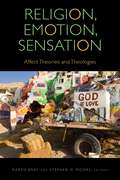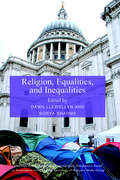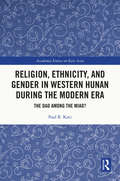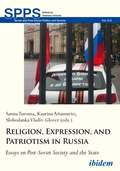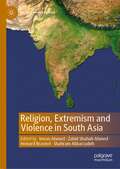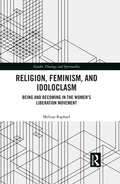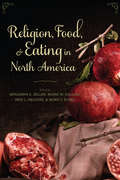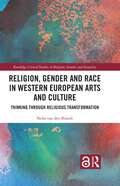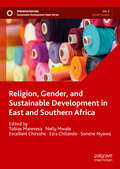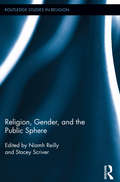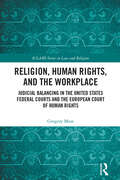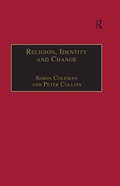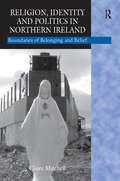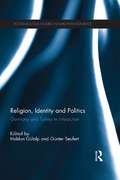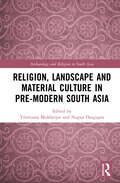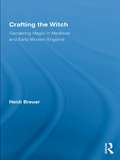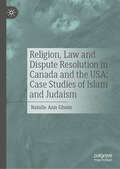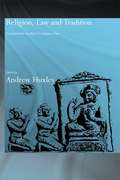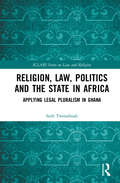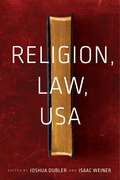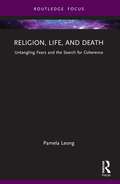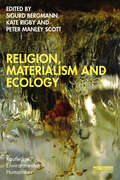- Table View
- List View
Religion, Emotion, Sensation: Affect Theories and Theologies (Transdisciplinary Theological Colloquia)
by Karen Bray and Stephen D. MooreReligion, Emotion, Sensation asks what affect theory has to say about God or gods, religion or religions, scriptures, theologies, and liturgies. Contributors explore the crossings and crisscrossings between affect theory and theology and the study of religion more broadly, as well as the political and social import of such work.Bringing together affect theorists, theologians, biblical scholars, and scholars of religion, this volume enacts creative transdisciplinary interventions in the study of affect and religion through exploring such topics as biblical literature, Christology, animism, Rastafarianism, the women’s Mosque Movement, the unending Korean War, the Sewol ferry disaster, trans and gender queer identities, YA fiction, queer historiography, the prison industrial complex, debt and neoliberalism, and death and poetry.Contributors: Mathew Arthur, Amy Hollywood, Wonhee Anne Joh, Dong Sung Kim, A. Paige Rawson, Erin Runions, Donovan O. Schaefer, Gregory J. Seigworth, Max Thornton, Alexis G. Waller
Religion, Equalities, and Inequalities (Theology and Religion in Interdisciplinary Perspective Series in Association with the BSA Sociology of Religion Study Group)
by Sonya Sharma Dawn LlewellynPresenting cutting edge research on how religion can confront and obscure social inequalities in everyday life, Religion, Equalities and Inequalities argues that when religion is left out of social scientific analyses, it can result in incomplete analyses that conceal pathways to social inclusion and exclusion. Bringing together an international and interdisciplinary group of contributors who operate at the vanguard of theoretical and empirical work on how social structures of power, institutions and bodies can generate equalities and inequalities in religion, the collection shows how religion can enable and challenge the inequities that affect people’s everyday lives. Academics and students of religious studies, sociology, politics and social policy will all find this book offers useful insights into the relationship between religion and contemporary culture.
Religion, Ethnicity, and Gender in Western Hunan during the Modern Era: The Dao among the Miao? (Academia Sinica on East Asia)
by Paul R. KatzThis book explores how beliefs and practices have shaped the interactions between different ethnic groups in Western Hunan, as well as considering how religious life has adapted to the challenges of modern Chinese history. Combining historical and ethnographic methodologies, chapters in this book are structured around changes that occurred during the interaction between Miao ritual traditions and religions such as Daoism, with particular focus on the commonalities and differences seen between Western Hunan and other areas of Southwest China. In addition, investigation is made into how gender and ethnicity have shaped such processes, and what these phenomena can teach about larger questions of modern Chinese history. As such, this study transcends existing scholarship on Western Hunan – which has stressed the impact of state policies and elite agendas – by focusing instead on the roles played by ritual specialists. Such findings call into question conventional wisdom about the ‘standardization’ of Chinese culture, as well as the integration of local society into the state by means of written texts. Religion, Ethnicity, and Gender in Western Hunan during the Modern Era will prove valuable to students and scholars of history, ethnography, anthropology, ethnic studies, and Asian studies more broadly.
Religion, Expression, and Patriotism in Russia: Essays on Post-Soviet Society and the State (Soviet and Post-Soviet Politics and Society #213)
by Sanna TuromaThe 2010s saw an introduction of legislative acts about religion, sexuality, and culture in Russia, which caused an uproar of protests. They politicized areas of life commonly perceived as private and expected to be free of the state's control. As a result, political activism and radical grassroots movements engaged many Russians in controversies about religion and culture and polarized popular opinion in the capitals and regions alike. This volume presents seven case studies that probe into the politics of religion and culture in today's Russia. The contributions highlight the diversity of Russia's religious communities and cultural practices by analyzing Hasidic Jewish identities, popular culture sponsored by the Orthodox Church, literary mobilization of the National Bolshevik Party, cinematic narratives of the Chechen wars, militarization of political Orthodoxy, and moral debates caused by opera as well as film productions. The authors draw on a variety of theoretical approaches and methodologies, including opinion surveys, ethnological fieldwork, narrative analysis, Foucault's conceptualization of biopower, catachrestic politics, and sociological theories of desecularization. The volume’s contributors are Sanna Turoma, Kaarina Aitamurto, Tomi Huttunen, Susan Ikonen, Boris Knorre, Irina Kotkina, Jussi Lassila, Andrey Makarychev, Elena Ostrovskaya, and Mikhail Suslov.
Religion, Extremism and Violence in South Asia (Politics of South Asia)
by Imran Ahmed Shahram Akbarzadeh Howard Brasted Zahid Shahab AhmedThis book sheds light on religiously motivated extremism and violence in South Asia, a phenomenon which ostensibly poses critical and unique challenges to the peace, security and governance not only of the region, but also of the world at large. The book is distinctive in-so-far as it reexamines conventional wisdom held about religious extremism in South Asia and departs from the literature which centres its analyses on Islamic militancy based on the questions and assumptions of the West’s ‘war on terror’. This volume also offers a comprehensive analysis of new extremist movements and how their emergence and success places existing theoretical frameworks in the study of religious extremism into question. It further examines topical issues including the study of social media and its impact on the evolution and operation of violent extremism. The book also analyses grassroots and innovative non-state initiatives aimed to counter extremist ideologies. Through case studies focusing on Bangladesh, India, Pakistan and Sri Lanka, this collection examines extremist materials, methods of political mobilisation and recruitment processes and maps the interconnected nature of sociological change with the ideological transformations of extremist movements.
Religion, Feminism, and Idoloclasm: Being and Becoming in the Women's Liberation Movement (Gender, Theology and Spirituality)
by Melissa RaphaelReligion, Feminism, and Idoloclasm identifies religious and secular feminism’s common critical moment as that of idol-breaking. It reads the women’s liberation movement as founded upon a philosophically and emotionally risky attempt to liberate women’s consciousness from a three-fold cognitive captivity to the self-idolizing god called ‘Man’; the ‘God’ who is a projection of his power, and the idol of the feminine called ‘Woman’ that the god-called-God created for ‘Man’. Examining a period of feminist theory, theology, and culture from about 1965 to 2010, this book shows that secular, as well as Christian, Jewish, and post-Christian feminists drew on ancient and modern tropes of redemption from slavery to idols or false ideas as a means of overcoming the alienation of women’s being from their own becoming. With an understanding of feminist theology as a pivotal contribution to the feminist criticism of culture, this original book also examines idoloclasm in feminist visual art, literature, direct action, and theory, not least that of the sexual politics of romantic love, the diet and beauty industry, sex robots, and other phenomena whose idolization of women reduces them to figures of the feminine same, experienced as a de-realization or death of the self. This book demonstrates that secular and religious feminist critical engagements with the modern trauma of dehumanization were far more closely related than is often supposed. As such, it will be vital reading for scholars in theology, religious studies, gender studies, visual studies, and philosophy.
Religion, Food, and Eating in North America
by Reid L. Neilson Nora L. Rubel Benjamin E. Zeller Martha L. Finch Marie W. DallamThe way in which religious people eat reflects not only their understanding of food and religious practice but also their conception of society and their place within it. This anthology considers theological foodways, identity foodways, negotiated foodways, and activist foodways in the United States, Canada, and the Caribbean. Original essays explore the role of food and eating in defining theologies and belief structures, creating personal and collective identities, establishing and challenging boundaries and borders, and helping to negotiate issues of community, religion, race, and nationality. Contributors consider food practices and beliefs among Christians, Jews, Muslims, and Buddhists, as well as members of new religious movements, Afro-Carribean religions, interfaith families, and individuals who consider food itself a religion. They traverse a range of geographic regions, from the Southern Appalachian Mountains to North America's urban centers, and span historical periods from the colonial era to the present. These essays contain a variety of methodological and theoretical perspectives, emphasizing the embeddedness of food and eating practices within specific religions and the embeddedness of religion within society and culture. The volume makes an excellent resource for scholars hoping to add greater depth to their research and for instructors seeking a thematically rich, vivid, and relevant tool for the classroom.
Religion, Food, and Eating in North America (Arts and Traditions of the Table: Perspectives on Culinary History)
by Reid L. Neilson Nora L. Rubel Benjamin E. Zeller Marie W. DallamThe way in which religious people eat reflects not only their understanding of food and religious practice but also their conception of society and their place within it. This anthology considers theological foodways, identity foodways, negotiated foodways, and activist foodways in the United States, Canada, and the Caribbean. Original essays explore the role of food and eating in defining theologies and belief structures, creating personal and collective identities, establishing and challenging boundaries and borders, and helping to negotiate issues of community, religion, race, and nationality.Contributors consider food practices and beliefs among Christians, Jews, Muslims, and Buddhists, as well as members of new religious movements, Afro-Caribbean religions, interfaith families, and individuals who consider food itself a religion. They traverse a range of geographic regions, from the Southern Appalachian Mountains to North America's urban centers, and span historical periods from the colonial era to the present. These essays contain a variety of methodological and theoretical perspectives, emphasizing the embeddedness of food and eating practices within specific religions and the embeddedness of religion within society and culture. The volume makes an excellent resource for scholars hoping to add greater depth to their research and for instructors seeking a thematically rich, vivid, and relevant tool for the classroom.
Religion, Gender and Race in Western European Arts and Culture: Thinking Through Religious Transformation (Routledge Critical Studies in Religion, Gender and Sexuality)
by Nella van den BrandtThis book examines narratives of individual religious transformation in Western European literature and culture. Religious individuals, themes, experiences and communities are widely represented in diverse literature and culture, including literary texts and visual arts and media. Taking the subject of religious transformation as an angle from which to study constructions of religion, gender and race, this book reveals through various case studies what authors, documentary makers, film makers and playwrights consider to be important (possible) shifts between the old and the new, continuities and discontinuities, and the formation of the self. The chapters demonstrate how individual religious transformations are understood to be shaped by various intersections of difference, and point at the need to consider gender as always related to and co-constructing religion and race. This transdisciplinary and intimate study provides a fresh lens through which to examine pressing questions regarding the place and future of religion, gender and race in contemporary Western Europe.
Religion, Gender and Race in Western European Arts and Culture: Thinking Through Religious Transformation (Routledge Critical Studies in Religion, Gender and Sexuality)
by Nella van den BrandtThis book examines narratives of individual religious transformation in Western European literature and culture. Religious individuals, themes, experiences and communities are widely represented in diverse literature and culture, including literary texts and visual arts and media. Taking the subject of religious transformation as an angle from which to study constructions of religion, gender and race, this book reveals through various case studies what authors, documentary makers, film makers and playwrights consider to be important (possible) shifts between the old and the new, continuities and discontinuities, and the formation of the self. The chapters demonstrate how individual religious transformations are understood to be shaped by various intersections of difference, and point at the need to consider gender as always related to and co-constructing religion and race. This transdisciplinary and intimate study provides a fresh lens through which to examine pressing questions regarding the place and future of religion, gender and race in contemporary Western Europe.
Religion, Gender, and Sustainable Development in East and Southern Africa (Sustainable Development Goals Series)
by Ezra Chitando Tobias Marevesa Nelly Mwale Excellent Chireshe Sonene NyawoThis volume brings to the fore the intersections of religion, gender and sustainable development in 21st century Africa from an interdisciplinary perspective. The volume explores and presents a coherent, research supported argument for the role of religion in promoting gender justice and sustainable development. Contributing authors explicate how the nexus between religion and gender can be utilized as the backdrop for achieving sustainable development in Africa, focusing on Sustainable Development Goal (SDG) 5, “Achieve gender equality and empower all women and girls.” Chapters in this volume focus on a variety of topics, including, how African Traditional Religions, Christianity (mainline, AICs, Pentecostalism), Islam, Rastafari, etc., are being used to promote SDG 5 in African countries.
Religion, Gender, and the Public Sphere: Religion, Gender, And The Public Sphere (Routledge Studies in Religion)
by Niamh Reilly Stacey ScriverThe re-emergence of religion as a significant cultural, social and political, force is not gender neutral. Tensions between claims for women’s equality and the rights of sexual minorities on one side and the claims of religions on the other side are well-documented across all major religions and regions. It is also well recognized in feminist scholarship that gender identities and ethno-religious identities work together in complex ways that are often exploited by dominant groups. Hence, a more comprehensive understanding of the changing role and influence of religion in the public sphere more widely requires complex, multidisciplinary and comparative gender analyses. Most recent discussion on these matters, however, especially in Europe, has focused primarily on the perceived subordinate status of Muslim women. These debates are a reminder of the deep interrelation of questions of gender, identity, human rights and religious freedom more generally. The relatively narrow (albeit important) purview of such discussions so far, however, underscores the need to extend the horizon of enquiry vis-à-vis religion, gender and the public sphere beyond the binary of ‘Islam versus the West’. Religion, Gender and the Public Sphere moves gender from the periphery to the centre of contemporary debates about the role of religion in public and political life. It offers a timely, multidisciplinary collection of gender-focused essays that address an array of challenges arising from the changing role and influence of religious organisations, identities, actors and values in the public sphere in contemporary multicultural and democratic societies.
Religion, Human Rights, and the Workplace: Judicial Balancing in the United States Federal Courts and the European Court of Human Rights (ICLARS Series on Law and Religion)
by Gregory MoseReligious freedom is a fundamental and relatively uncontested right in both the United States and Europe. But other values like equality, justice, and the right to a private life are just as precious. Managing such conflicts has become a highly contested and politicized area of law and nowhere are such conflicts more evident – or more challenging – than those arising in the workplace. By comparing United States Federal Courts’ approach to free exercise in the workplace with that of the European Court of Human Rights, this book explores two very different methodologies for adjudicating rights conflicts. In examining methods and results, case by case, issue by issue and addressing each step of the analytical processes taken by judges, it becomes apparent that the United States has lost its way in the quest for equality and justice. It is argued here that while the European approach has its own flaws, its proportionality approach may offer vital lessons for United States practice. The book will make compelling reading for researchers, academics, and policy-makers working in the areas of law and religion, human rights law, constitutional law, and comparative law.
Religion, Identity and Change: Perspectives on Global Transformations (Theology and Religion in Interdisciplinary Perspective Series in Association with the BSA Sociology of Religion Study Group)
by Simon Coleman Peter CollinsReligion is of enduring importance in the lives of many people, yet the religious landscape has been dramatically transformed in recent decades. Established churches have been challenged by eastern faiths, revivals of Christian and Islamic fundamentalism, and the eclectic spiritualities of the New Age. Religion has long been regarded by social scientists and psychologists as a key source of identity formation, ranging from personal conversion experiences to collective association with fellow believers. This book addresses the need for a reassessment of issues relating to identity in the light of current transformations in society as a whole and religion in particular. Drawing together case-studies from many different expressions of faith and belief - Hindu, Muslim, Roman Catholic, Anglican, New Age - leading scholars ask how contemporary religions or spiritualities respond to the challenge of forming individual and collective identities in a nation context marked by secularisation and postmodern decentring of culture, as well as religious revitalisation. The book focuses on Britain as a context for religious change, but asks important questions that are of universal significance for those studying religion: How is personal and collective identity constructed in a world of multiple social and cultural influences? What role can religion play in creating, reinforcing or even transforming such identity?
Religion, Identity and Politics in Northern Ireland: Boundaries of Belonging and Belief
by Claire MitchellHas conflict in Northern Ireland kept political dimensions of religion alive, and has religion played a role in fuelling conflict? Conflict in Northern Ireland is not and never will be a holy war. Yet religion is more socially and politically significant than many commentators presume. In fact, religion has remained a central feature of social identity and politics throughout conflict as well as recent change. There has been an acceleration of interest in the relationship between religion, identity and politics in modern societies. Building on this debate, Claire Mitchell presents a challenging analysis of religion in contemporary Northern Ireland, arguing that religion is not merely a marker of ethnicity and that it continues to provide many of the meanings of identity, community and politics. In light of the multifaceted nature of the conflict in Northern Ireland, Mitchell explains that, for Catholics, religion is primarily important in its social and institutional forms, whereas for many Protestants its theological and ideological dimensions are more pressing. Even those who no longer go to church tend to reproduce religious stereotypes of 'them and us'. Drawing on a range of unique interview material, this book traces how individuals and groups in Northern Ireland have absorbed religious types of cultural knowledge, belonging and morality, and how they reproduce these as they go about their daily lives. Despite recent religious and political changes, the author concludes that perceptions of religious difference help keep communities in Northern Ireland socially separate and often in conflict with one another.
Religion, Identity and Politics: Germany and Turkey in Interaction (Studies in European Sociology)
by Haldun Gülalp Günter SeufertGerman–Turkish relations, which have a long history and generally unrecognized depth, have rarely been examined as mutually formative processes. Isolated instances of influence have been examined in detail, but the historical and still ongoing processes of mutual interaction have rarely been seriously considered. The ruling assumption has been that Germany may have an impact on Turkey, but not the other way around. Religion, Identity and Politics examines this mutual interaction, specifically with regard to religious identities and institutions. It opposes the commonly held assumption that Europe is the abode of secularism and enlightenment, while the lands of Islam are the realm of backwardness and fundamentalism. Both historically and contemporarily, Germany has treated religion as a core aspect of communal and civilizational identity and framed its institutions accordingly; the book explores how there has been, and continues to be, a mutual exchange in this regard between Germany and both the Ottoman Empire and modern Turkey. The authors show that the definition of identity and regulation of communities have been explicitly based on religion until the early and since the late twentieth century; the period in between– the age of secular nationalism– which has always been treated as the norm, now appears more clearly as an exception. This book will be of interest to students and scholars of sociology, politics, history and religion.
Religion, Landscape and Material Culture in Pre-modern South Asia (Archaeology and Religion in South Asia)
by Tilottama Mukherjee and Nupur DasguptaThis book highlights emerging trends and new themes in South Asian history. It covers issues broadly related to religion, materiality and nature from differing perspectives and methods to offer a kaleidoscopic view of Indian history until the late eighteenth century. The essays in the volume focus on understanding questions of premodern religion, material culture processes and their spatial and environmental contexts through a study of networks of commodities and cultural and religious landscapes. From the early history of coastal regions such as Gujarat and Bengal to material networks of political culture, from temples and their connection with maritime trade to the importance of landscape in influencing temple-building, from regions considered peripheral to mainstream historiography to the development of religious sects, this collection of articles maps the diverse networks and connections across regions and time. The volume will be of great interest to scholars and researchers of history, archaeology, museum and heritage studies, religion, especially Hinduism, Sufism and Buddhism, and South Asian studies.
Religion, Language, and Power (Routledge Studies in Religion)
by Nile Green Mary Searle-ChatterjeeReligion, Language and Power shows that the language of ‘religion’ is far from neutral, and that the packaging and naming of what English speakers call ‘religious’ groups or identities is imbued with the play of power. Religious Studies has all too often served to amplify voices from other centers of power, whether scripturalist or otherwise normative and dominant. This book’s de-centering of English classifications goes beyond the remit of most postcolonial studies in that it explores the classifications used in a range of languages — including Arabic, Sanskrit, Chinese, Greek and English — to achieve a comparative survey of the roles of language and power in the making of ‘religion’ . In contextualizing these uses of language, the ten contributors explore how labels are either imposed or emerge interactively through discursive struggles between dominant and marginal groups. In dealing with the interplay of religion, language and power, there is no other book with the breadth of this volume.
Religion, Law and Dispute Resolution in Canada and the USA: Case Studies of Islam and Judaism
by Natalie Ann GhosnThe book is about the role of religious leadership in settling disputes of a legal nature within religious communities and the effects of this process on immigrant integration in Canada and the USA. The community-based practice of law in Jewish (Orthodox, Conservative and Reform) & Muslim (Sunni) communities in Canada and the USA are the communities studied here. The role of religious leadership, the gender implications of this type of dispute resolution and the implications for immigrant integration are all explored among a number of other topics.
Religion, Law and Society
by Russell SandbergIssues concerning religion in the public sphere are rarely far from the headlines. As a result, scholars have paid increasing attention to religion. These scholars, however, have generally stayed within the confines of their own respective disciplines. To date there has been little contact between lawyers and sociologists. Religion, Law and Society explores whether, how and why law and religion should interact with the sociology of religion. It examines sociological and legal materials concerning religion in order to find out what lawyers and sociologists can learn from each other. A groundbreaking, provocative and thought-provoking book, it is essential reading for lawyers, sociologists and all who are interested in the relationship between religion, law and society in the twenty-first century.
Religion, Law and Tradition: Comparative Studies in Religious Law
by Andrew HuxleyThis book brings together two scholarly traditions: experts in Roman, Jewish and Islamic law, an area where scholars tend to be familiar with work in each area, and experts in the legal traditions of South and East Asia, which have tended to be less interdisciplinary. The resulting mix produces new ways of looking at comparative law and legal history from a global perspective, and these essays contribute both to our understanding of comparative religion as well as comparative law.
Religion, Law, Politics and the State in Africa: Applying Legal Pluralism in Ghana (ICLARS Series on Law and Religion)
by Seth TweneboahApplying a legal pluralist framework, this study examines the complex interrelationships between religion, law and politics in contemporary Ghana, a professedly secular State characterised by high levels of religiosity. It aims to explore legal, cultural and moral tensions created by overlapping loci of authority (state actors, traditional leaders and religious functionaries). It contends that religion can function as an impediment to Ghana’s secularity and also serve as an integral tool for realising the State’s legal ideals and meeting international human rights standards. Using three case studies – legal tensions, child witchcraft accusations and same-sex partnerships – the study illustrates the ways that the entangled and complicated connections between religion and law compound Ghana’s secular orientation. It suggests that legal pluralism is not a mere analytical framework for describing tensions, but ought to be seen as part of the solution. The study contributes to advancing knowledge in the area of the interrelationships between religion and law in contemporary African public domain. This book will be a valuable resource for those working in the areas of Law and Religion, Religious Studies, African Studies, Political Science, Legal Anthropology and Socio-legal Studies.
Religion, Law, USA (North American Religions #8)
by Isaac Weiner Joshua DublerOffers insight into the complex relationship between religion and law in contemporary America Why religion? Why law? Why now? In recent years, the United States has witnessed a number of high-profile court cases involving religion, forcing Americans to grapple with questions regarding the relationship between religion and law. This volume maps the contemporary interplay of religion and law within the study of American religions. What rights are protected by the Constitution’s free exercise clause? What are the boundaries of religion, and what is the constitutional basis for protecting some religious beliefs but not others? What characterizes a religious-studies approach to religion and law today? What is gained by approaching law from the vantage point of religious studies, and what does attention to the law offer back to scholars of religion? Religion, Law, USA considers all these questions and more. Each chapter considers a specific keyword in the study of religion and law, such as “conscience,” “establishment,” “secularity,” and “personhood.” Contributors consider specific case studies related to each term, and then expand their analyses to discuss broader implications for the practice and study of American religion. Incorporating pieces from leading voices in the field, this book is an indispensable addition to the scholarship on religion and law in America.
Religion, Life, and Death: Untangling Fears and the Search for Coherence (Routledge Advances in Sociology)
by Pamela LeongBased on a content analysis of writing assignments from a class on death and dying, this book focuses on the manner in which college students use religion to make sense of death and the dying process. Drawing on research spanning five years, the author considers the attitudes, concerns, and beliefs about death, exploring students’ perspectives on the place of religion in end-of-life issues. With attention to questions related to death anxiety, suicide, mass homicide, and the death of young children, the author examines the ways in which students draw on religion to make sense of death, religion’s function as both a source of comfort and empowerment and a source of distress, as well as the perceptions of those who resist religion. As such, Religion, Life, and Death will appeal to social scientists with interests in the sociology of young adults, and the sociology and psychology of religion, death, and dying.
Religion, Materialism and Ecology (Routledge Environmental Humanities)
by Sigurd Bergmann, Kate Rigby and Peter Manley ScottThis timely collection of essays by leading international scholars across religious studies and the environmental humanities advances a lively discussion on materialism in its many forms. While there is little agreement on what ‘materialism’ means, it is evident that there is a resurgence in thinking about matter in more animated and active ways. The volume explores how debates concerning the new materialisms impinge on religious traditions and the extent to which religions, with their material culture and beliefs in the Divine within the material, can make a creative contribution to debates about ecological materialisms. Spanning a broad range of themes, including politics, architecture, hermeneutics, literature and religion, the book brings together a series of discussions on materialism in the context of diverse methodologies and approaches. The volume investigates a range of issues including space and place, hierarchy and relationality, the relationship between nature and society, human and other agencies, and worldviews and cultural values. Drawing on literary and critical theory, and queer, philosophical, theological and social theoretical approaches, this ground-breaking book will make an important contribution to the environmental humanities. It will be a key read for postgraduate students, researchers and scholars in religious studies, cultural anthropology, literary studies, philosophy and environmental studies.
